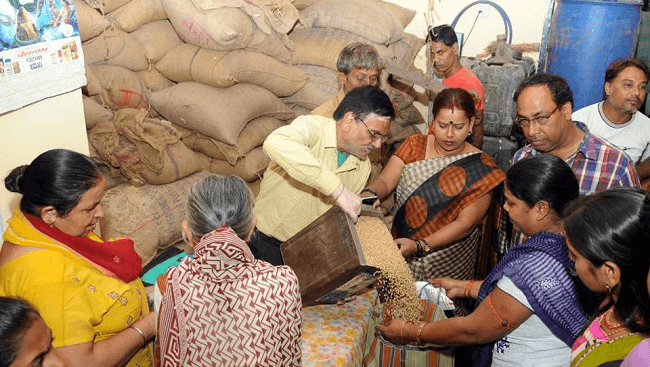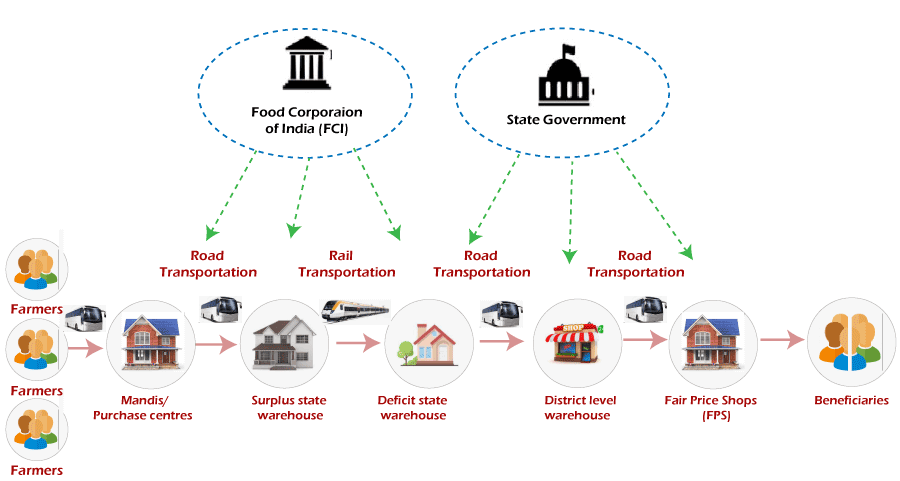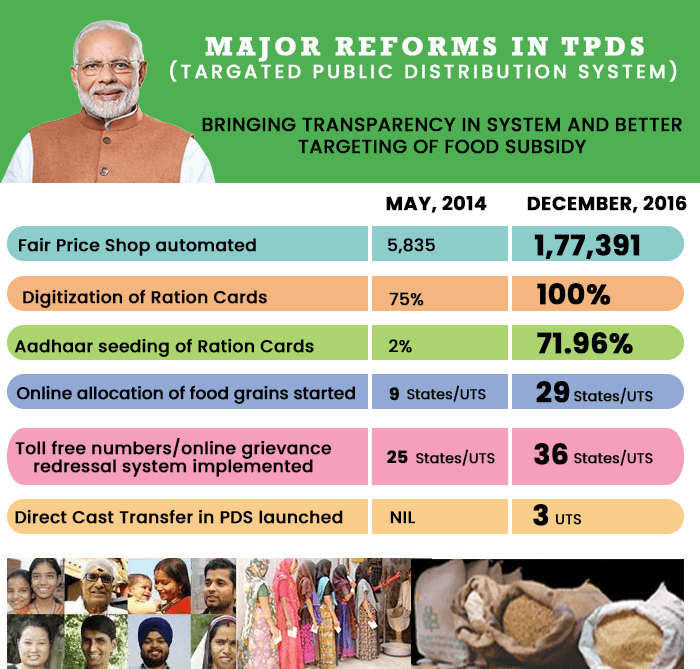What is the full form of PDS
PDS: Public Distribution System
PDS stands for Public Distribution System. The Public Distribution System is a food security programme initiated by the Ministry of Consumer Affairs, Food, and Public Distribution. This was developed as a strategy for addressing scarcity through the economic distribution of food grains. This System was managed by the central and state governments.

The Food Corporation of India, a part of the Central Government, is currently responsible for purchasing, storing, transporting, and distributing food grains in large quantities to the State Governments. The State Governments are responsible for carrying out the operational duties, such as distributing resources within the State, identifying eligible families under the PDS System, providing ration cards to them, and supervising the operation of Fair Price Shops. By the PDS, the States and Union Territories are currently providing distribution rights for commodities like wheat, rice, sugar, and oil. Pulses, edible oils, salt, spices, and other goods are distributed in large quantities through PDS outlets in some states and Union territories.
History of Public Distribution System
- The Public Distribution System was introduced by the Britishers after the Second World War as a ration system.
- Before the 1960s, the distribution of commodities through the PDS system was totally dependent on importing food grains from other countries.
- In the 1960s it was further enhanced to address the food shortages within India.
- After that, the government launched the Agriculture Price Commission and the Food Corporation of India to improve the nation's capacity to purchase and store food grains for the Public Distribution System.
- In the 1970s, the Public Distribution System was developed as a universal scheme for distributing subsidized or discounted commodities to all citizens.
- Before 1992, the Public Distribution System was a general insurance scheme for all citizens without specific targets like the poor.
- The Revamped Public Distribution System was also developed in 1992 to improve and simplify the Public Distribution System. It also aimed to reach consumers in remote areas where many poor were present.
- After that, the Indian government launched the Targeted Public Distribution System in 1997. In accordance with this new system, the consumers were separated into two groups:
- Low-Income Families that are Below Poverty Line, also known as BPL
- Medium Income Families that are Above Poverty Line, also known as APL
- Antyodaya Anna Yojana was launched in the year 2000 for the poorest of the poor to provide them with food at a cheap rate. This scheme was further improved twice in the years 2003 and 2004. The families eligible for this scheme were provided with a unique Antyodaya Ration Card. This yellow ration card acted as a form of identification to receive the level of rations the card specifies.
- In September 2013, the National Food Security Act became law. This Act provided legal rights to the poor through the existing Targeted Public Distribution System, which is how the Right to Food became a constitutional right.
Working of Public Distribution System
- The Central and State governments share the responsibility for providing subsidized goods to consumers under the Targeted Public Distribution System.
- The Central Government is responsible for purchasing grains from the farmers at a Minimum Support Price.
- Then the purchased grains are sold at the prices issued by the Central Government.
- The Central Government is also responsible for transporting the goods to the warehouses of the different States.
- The State Government is responsible for transporting the commodities from the warehouses to each ration shop or retail shop, where the consumers purchase these commodities at a centrally issued price.
- The State governments further have the power to reduce the price of commodities in the ration shops.

Importance of Public Distribution System
- PDS is an essential system by the government to ensure Food and Nutrition Security for the Nation.
- It assures the availability of food grains to the poor at an affordable price.
- It also provides financial support to the farmers through the minimum support price schemes and procurement of the grains by the government.
- It allows the conservation of the food grain as a buffer stock, ensuring that the flow of food is unaffected even when agricultural returns are lower in conditions like floods and drought.
- It ensures the redistribution of grains by supplying them from regions with abundant stock to areas that do not have enough grains to distribute to all consumers.
Problems faced by Public Distribution System
- The mechanisms, like the Targeted Public Distribution system, have made specific errors in the inclusion of consumers. Some of the needy are left out, and those who do not need them get excess benefits. An estimate of the 2009 census states that there was a misclassification between the poor and the non-poor, resulting in a massive loss to the poor section of society.
- There is a huge loss of food grains during transportation. These losses occur when the food grains are transported to and from ration shops into the open market.
- There is a shortage of grains in the open market due to open-ended procurement, which means that all arriving grains are accepted even when there is an excess in the buffer stock. This prevents the expansion of other associated industries.
- The Food Corporation of India, the government agency in charge of the Public Distribution System, is frequently criticised for differentiating between urban and rural areas. It is also known for corrupt practices and illegal trade.
- The government's increased procurement is increasing food rotting and waste. There have been concerns about the quality of food stored due to a lack of sufficient covered storage.
- Minimum support prices have encouraged farmers to grow more rice and wheat rather than coarse grains consumed by the poor.
- The increased emphasis on achieving self-sufficiency and surplus has resulted in the over-consumption of water and land degradation. It has resulted in unsustainable agricultural practices. The use of fertilisers causes environmental problems such as groundwater depletion, deteriorating soil, and water pollution.

Reforms made by the Public Distribution System in recent years
- Linking Aadhar with the Targeted Public Distribution System has improved the accuracy of identifying TPDS recipients. In a study conducted by the Unique Identification Authority of India, Aadhar has helped remove fake recipients. It has made identification more accessible and more accurate.
- The Tamil Nadu government implemented the Universal PDS, which allowed every household in the state to obtain subsidized grains.
- The digitalization of Ration Cards enabled online registration and verification of recipients. Andhra Pradesh, Tamil Nadu, Chhattisgarh, Madhya Pradesh, Karnataka, and other states have this power.
- Computer-controlled allocations to Ration Shops facilitated quick and efficient tracking of grain transactions within states. These reforms are being executed in states such as Chhattisgarh, Delhi, Madhya Pradesh, and Tamil Nadu.
- Several states, including Haryana and Andhra Pradesh, are issuing Smart Cards instead of ration cards. Due to this reform, recipients' data are now stored in secure electronic devices. It promotes transparency and prevents counterfeiting.
- Governments in Tamil Nadu, Chhattisgarh, and Uttar Pradesh have registered recipients' mobile numbers so they can receive alerts when different commodities are dispatched and arrived.
Public Distribution System in Future
- PDS is one of the government's most extensive welfare programmes. It assists farmers in selling their produce at fair prices and allows the poorer sections of society to purchase food grains at reasonable prices.
- Its effectiveness can be increased with technology-based solutions, as evidenced by some states.
- In its report on state finances, the Reserve Bank of India advised states planning to switch to cash transfers to proceed with caution.
- Training and skill development for implementation authorities are crucial for improving the Targeted Public Distribution System's existing capacity.
- To ensure transparency and accountability in the existing Targeted Public Distribution System at the base level, the government must encourage Self-help groups, cooperatives, and Non-Governmental Organizations to participate.
- The government must encourage purchasing a wide variety of grains so that people's diets are not entirely controlled by wheat or rice.
Advantages of Public Distribution System
- It ensures food security for the poor section of society.
- It aids in the reduction of India's poverty rate.
- It ensures that no person dies from hunger.
- It contributes significantly to the stabilisation of food prices.
- It ensures that food is available at affordable and discounted prices.
Disadvantages of Public Distribution System
- The food grains supplied by ration shops are inadequate to meet the poor people's consumption needs.
- The quality of food grain is not good.
- Due to the corruption involved in identifying low-income families, the advantage of the Public Distribution System does not reach the poor and underprivileged sections of society.
- Ration shop managers frequently do not supply food grains to the poor at subsidised rates and instead distribute them at higher prices on the black market.
|



 For Videos Join Our Youtube Channel: Join Now
For Videos Join Our Youtube Channel: Join Now










